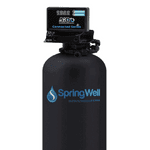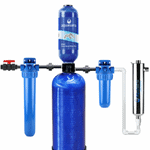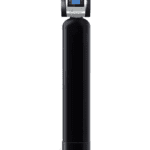We dug deep into performance specs, user feedback, and NSF certifications to find the top-rated filtration systems built specifically for private wells — no fluff, no gimmicks. Just reliable systems that actually work.
💡 Whether you’re dealing with metallic taste, rotten egg odor, orange stains, or invisible contaminants — these whole-house filters can handle it.
SpringWell WS earned our top spot with a 4.9/5 rating and thousands of glowing reviews to back it up.
Expert Picks
- Best Overall: SpringWell WS
- Best for Iron: SoftPro Iron Master
- Best For Sulfur: US Water Systems Matrix Infusion
- Best For Manganese: Pentair Iron and Manganese filter
- Best Cartridge filter: Express Water Heavy Metal Filter
- Best Sediment filter: iSpring 3-Stage
#1 SpringWell WS — Best Overall
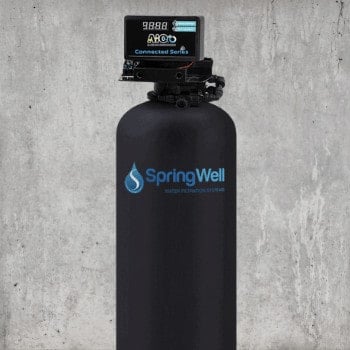
If your well water leaves stains, smells off, or feels unpredictable, this system brings it back under control — fast.
It tackles iron, sulfur, and manganese at the source, and with the mobile app, you’re always in control.
Features:
- 📶 Bluetooth lets you monitor usage, pressure & flow
- 🔇 Runs quietly in the background — no constant buzzing
- 🚿 You can shower, run laundry & dishwashers — all at once
- ⚙️ Auto-backwash keeps performance sharp without your input
- 🧾 Backed by real reviews — not marketing hype
Use Coupon Code: QWL5 to save!
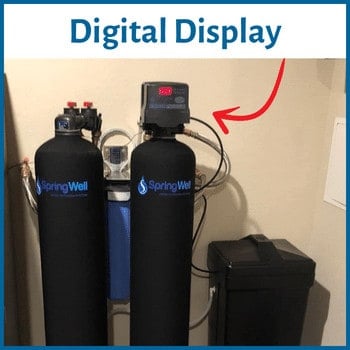
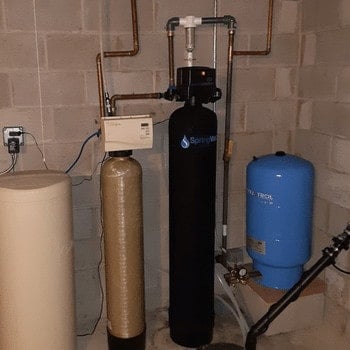
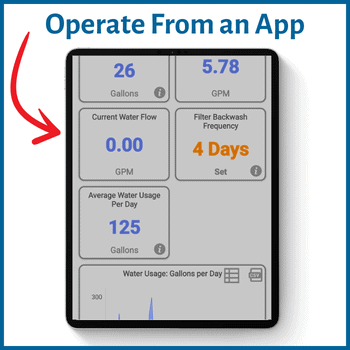
What we like
Let’s be honest — if you’ve dealt with that metallic tang in your water or mystery stains on your sink, you know how frustrating untreated well water can be. SpringWell WS doesn’t just hide the symptoms — it handles the cause.
With app-based controls and a rock-solid oxidation system, it quietly works in the background while you get back to using your water without second-guessing it.
Springwell WS carries a 4.9/5 rating with well over 1000+ positive reviews.

| ✅ Pros |
|---|
| 🧠 Smart app control makes monitoring effortless — no guessing when to backwash or check flow rates. |
| 🟢 Greensand media handles tough contaminants like iron and manganese without needing chemicals. |
| 🔇 Quiet regeneration process — no sudden clanks or loud cycles at night. |
| 📲 Bluetooth-enabled settings make it easy to adjust everything from your phone, not the basement. |
| 💧 Rare combo: High-flow rate *and* precision filtration for larger homes that demand both. |
| ⚠️ Cons |
|---|
| 💸 Upfront price is higher than most, but offset by long-term savings and performance. |
| 🔧 Some plumbing knowledge needed for DIY install — or plan to hire a pro. |
| 🔩 Plastic fittings on a premium system might leave you wishing for metal upgrades. |
SpringWell WS Product Updates:
- Boosted to handle up to 20 GPM, so no one has to fight over the shower.
- New UV add-on zaps bacteria and viruses before they reach your tap.
- Optional Flo Smart Monitor can shut off your water if it senses a leak — smart protection if you’re away.
- Add a water softener (salt or salt-free) if your well’s high in hardness.
- Comes with a free install kit to help get things up and running faster.
Use Coupon Code: QWL5 to save!
Want more details? Check out our full Springwell WS review.
#2 Aquasana Rhino — Best For Hard Water
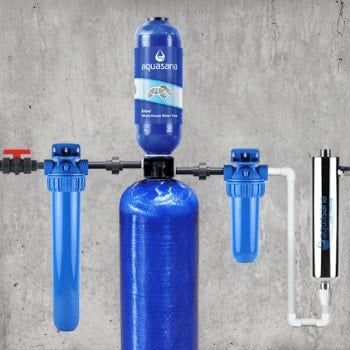
If your well water has that faintly sour or musty edge — or you’ve noticed buildup on fixtures — the Aquasana Rhino offers a solid middle ground.
It’s best for homes dealing with mild bacteria, scale, or murky taste, without the need for salt or constant tweaking. Not a fix-all, but a dependable choice for day-to-day water that just feels cleaner.
Features:
- 🔆 UV light zaps bacteria and viruses before they hit your tap
- 🔁 No backwashing required — filters are quick to swap out
- 💨 Upflow tank design keeps flow steady without clogging
- ⚙️ Optional descaler cuts down on limescale without salt
- 🛠️ Comes with upgraded brass fittings for leak-free performance
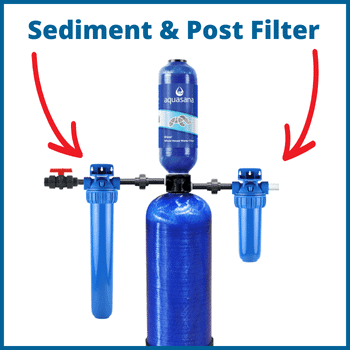
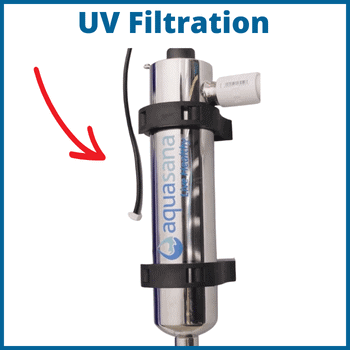
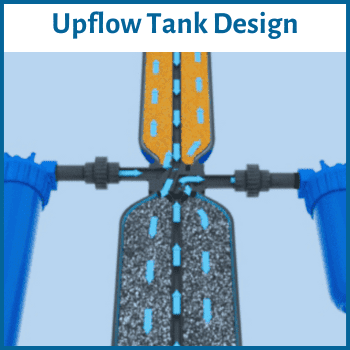
The Rhino’s a solid pick if your water’s generally clean but still has that “off” taste or weird smells. It’s easy to manage, doesn’t take up much space, and gives you peace of mind with that UV stage. Just don’t expect it to fix iron stains or that rotten egg smell — for that, you’ll want something tougher like the SoftPro Iron Master.
| ✨ Pros |
|---|
| 🧼 Filters out the stuff that affects taste and clarity, like sediment and bacteria — perfect if your water just doesn’t seem “right.” |
| 🦠 The UV stage gives extra peace of mind by knocking out pathogens, even if your well’s been a little sketchy lately. |
| 🛠️ Setup’s pretty painless, and you don’t need to be a plumber to swap out the filters. |
| 🔄 The pre-filter and upflow tank help with sediment buildup — no more clogs in your fixtures. |
| 🔧 Adjusting settings is straightforward — no confusing buttons or endless menus. |
| 🚿 Updated components now push water through at up to 15 GPM, which is great if you’ve got a busy household. |
| ⚠️ Cons |
|---|
| ❌ Not designed for removing iron — if you’ve got reddish stains, something like the SoftPro Iron Master is a better match. |
| 💡 Needs power for the UV light to work, which means it won’t function during outages unless you have a backup source. |
| 🔧 Installation may require a plumber if you want to maintain the warranty — not a simple DIY job for most people. |
| 💰 Filter replacements and UV bulb costs can creep up, especially if your water has high sediment or bacteria levels. |
💡 Worth Knowing: Aquasana’s upflow tank and UV combo are rare in this price range — especially with brass fittings and NSF-certified components. If you don’t have heavy metals or high iron, it’s one of the easiest systems to live with day-to-day.
#3 SoftPro Iron Master — Best For Iron
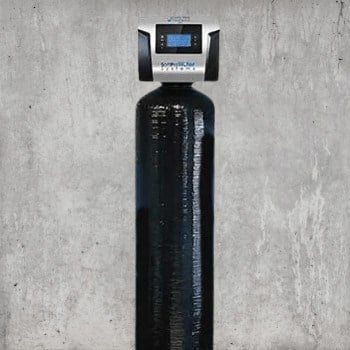
If you’ve got serious iron in your water, you already know the signs — orange rings in the toilet, bitter-tasting water, and laundry that never comes out clean. The SoftPro doesn’t just cover it up — it actually removes it.
It uses air to oxidize dissolved iron, then traps it in a Katalox bed before it ever reaches your pipes. Quiet, chemical-free, and easy to program, it’s a reliable fix for high iron without the constant upkeep.
Features:
- 🧲 Removes iron up to 30 PPM — one of the highest in its class
- 🌫️ Also cuts down on manganese and sulfur odors
- 🧪 Uses air injection + Katalox for chemical-free treatment
- 🔧 Programmable valve makes it easy to customize settings
- 🤫 Runs quietly in the background without disrupting your routine
- 💧 Includes quick-connect hoses for simple installation
- 📆 60-day money-back guarantee
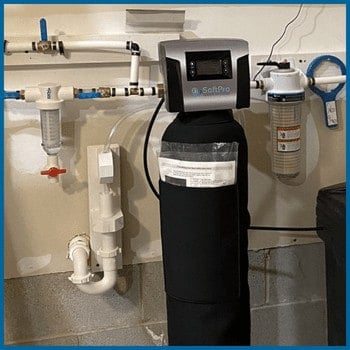
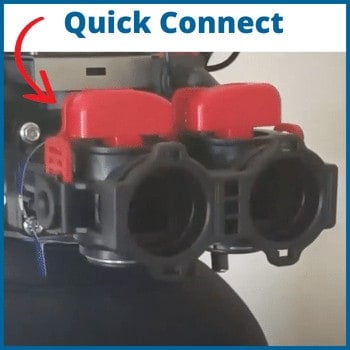
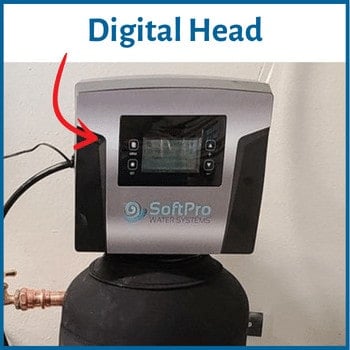
If you’ve been through filter after filter and nothing holds up to your iron levels, this system is a breath of fresh air. It’s not flashy, but it’s built to last — and you don’t have to babysit it. Just know that it’s not designed to handle heavy sediment out of the box, so if you’ve got cloudy or gritty water, a separate pre-filter is a smart add-on.
| ✅ Pros |
|---|
| 🧪 Removes up to 30 PPM of iron — far more than most systems handle |
| 🧱 Katalox media filters iron, manganese, and sulfur with no chemicals |
| 🔧 Fewer moving parts = fewer headaches down the road |
| 💧 Updated flow dividers help maintain steady pressure up to 12 GPM |
| 📏 Comes in multiple sizes — you don’t overpay for what you don’t need |
| 🛠️ Quick-connect hoses make DIY setup actually doable |
| ⏳ Low-maintenance once installed — filter media lasts 5–10 years |
| ⚠️ Cons |
|---|
| Doesn’t come with a sediment pre-filter — you’ll need to add one if your water has a lot of grit or sand. |
| Struggles with high hydrogen sulfide, so sulfur-heavy wells may need a different system. |
| Filter media needs occasional cleaning to stay effective — easy to forget until something goes wrong. |
🔧 Good to Know: Unlike many iron filters that rely on chemicals or need constant tweaking, the SoftPro Iron Master keeps things low-maintenance. Its Katalox media doesn’t just reduce iron — it also tackles manganese and hydrogen sulfide without additives or extra oxidizers.
Just note: it doesn’t come with a sediment pre-filter, so if you’re in an area with heavy particulates, adding one is a smart move to protect the system long-term.
Want to explore other top options? Check out our complete guide to iron filters for well water.
#4 US Water Systems Matrixx InFusion – Best For Sulfur Smells
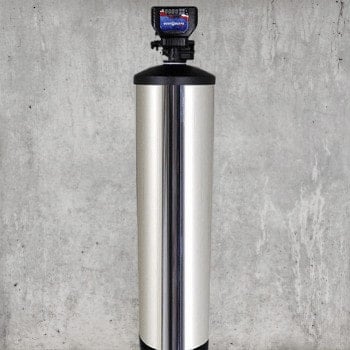
If your well water smells like rotten eggs, you know how hard that is to fix — especially if cheaper systems didn’t cut it.
The Matrixx Infusion uses peroxide injection to neutralize sulfur before it hits your tap. No filters to replace, just consistent results once it’s dialed in.
It’s not the cheapest option, but for stubborn sulfur? This one’s built for the job.
Features:
- 🔁 Automatic backwashing
- 🧪 Hydrogen peroxide injection
- 🧱 No filter replacements needed
- 📲 Bluetooth-enabled controls
- 🧼 NSF-certified components
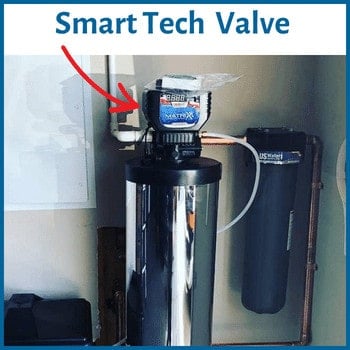
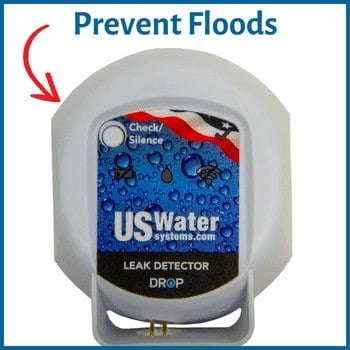
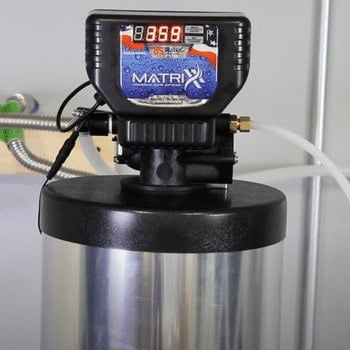
If sulfur’s been stinking up your water (think rotten eggs every time you run the tap), this system’s a solid fix. It’s a favorite in parts of Central Florida and Ohio where that “low tide” smell is all too common. Just keep in mind — hydrogen peroxide isn’t free. You’ll spend around $250–$400 a year to keep it running right, so it’s not ideal if you’re pinching pennies.
| ✅ Pros |
|---|
| ⚡ Sets up in under 30 seconds — super easy install |
| 💧 Uses 30% less water during backwash vs. typical units |
| 📱 App control makes it simple to monitor cycles and flow |
| 🔌 Only ~$2/year to run on 12V — ultra energy-efficient |
| 🛑 Leak detection add-on can auto shut off during emergencies |
| 📏 Available in 10, 15, 20, or 25 GPM sizes — pay for what you need |
| 🏗️ Built like a commercial system but made for home use |
| ❌ Cons |
|---|
| 💸 Higher annual cost due to hydrogen peroxide refills |
| 🧪 Peroxide feed pump needs occasional tweaking to stay dialed in |
| 🔄 Media doesn’t last as long as AIO-style iron filters |
| 🔧 Might be overkill if you’re not battling sulfur odors or iron stains |
✅ Smart Move: This system’s a standout for sulfur removal, but it does take some upkeep — hydrogen peroxide refills and a bit of setup. Not sure if that’s a dealbreaker? Here’s a quick look at other sulfur filter options.
#4 Pentair — Best For Manganese & Bacteria
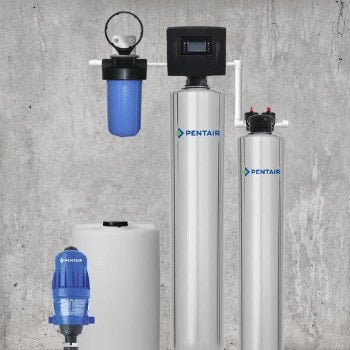
If your water’s leaving black or orange stains and smells a bit off, this Pentair system might be worth a closer look.
It uses a multi-stage setup that’s more like a water treatment plant than a basic filter — ideal for stubborn iron and manganese issues.
Just be ready for a higher price tag (and maybe some pro help with install).
Features
- 🔄 6-stage process – Tackles metals, sediment, and odors
- 🧠 Smart backwash cycles – Adjusts based on usage
- 🔵 NSF 42 & 61 parts – Verified for safety
- 🧱 Dual-tank option – Smoother flow during peak times
- 🛠️ Easy valve kit – Quick media swaps, no pro needed
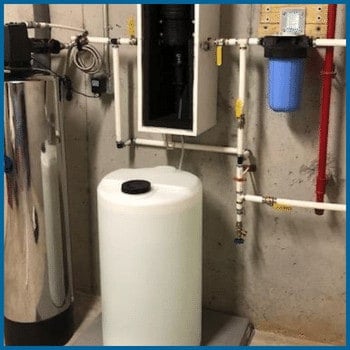
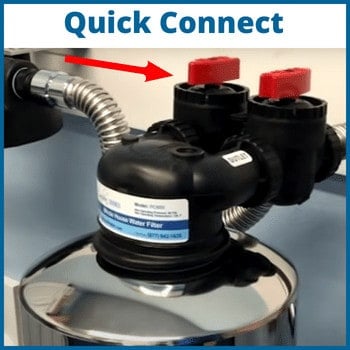
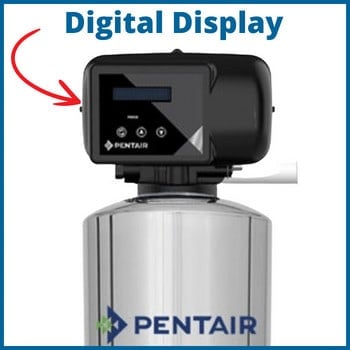
If you’ve already tried cheaper systems and are still dealing with weird water stains or that slimy residue in your sinks, this might be your fix. It’s not overkill — it’s just one of the few systems that actually targets the hard stuff. Not the cheapest, but if your water’s been a long-term headache, this one feels like a relief.
| ✅ Pros |
|---|
| 🕒 Runs like clockwork once dialed in — no constant filter swaps to worry about. |
| 🏠 Lets you match system size to your home’s demand, so you’re not paying for unused capacity. |
| 🔁 Backwash cycles are automatic, but you can fine-tune them if your water conditions shift. |
| 🧪 NSF 61 & 42 certified, which means it’s cleared for safety and performance. |
| 🚽 Built tough enough to run on a septic setup without dumping excess water. |
| ⚠️ Pros |
|---|
| 💸 Higher upfront cost — not ideal if you’re trying to cut corners. |
| 🧰 Not a plug-and-play system — installation can be tricky without plumbing experience. |
| 📦 Doesn’t include a sediment pre-filter — you’ll need to buy that separately. |
| 🔕 No smart features or app connectivity if that’s important to you. |
| 🛠️ Maintenance is simple but does require staying on top of backwash cycles. |
💡 Worth Knowing: This isn’t your average filter — it’s a chemical oxidation powerhouse built for water that other systems can’t handle. If bacteria, sulfur, or manganese have been winning the battle at your tap, this one fights back hard.
#6 iSpring 3-Stage Best Cartridge System
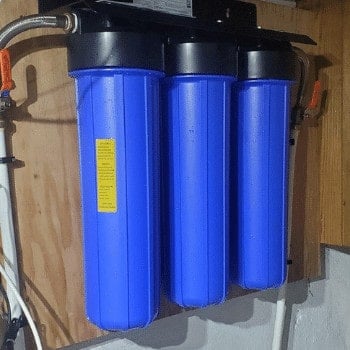
If your water tastes off or has that musty well smell, this 3-stage carbon system clears things up fast.
iSpring’s dual filters trap sediment and VOCs, while polishing the flavor — no bulky tanks or pressure drop to deal with.
It’s not meant for heavy-duty iron or sulfur, but for day-to-day cleanup? It’s a solid win in a compact setup.
Features:
- 🧽 Tackles sediment and weird chemical smells
- 🧰 Easy to mount and swap filters without calling a pro
- 🚿 Doesn’t choke your water pressure like some cartridges do
- 🧪 NSF-certified for peace of mind
- 💸 Filter replacements won’t drain your wallet
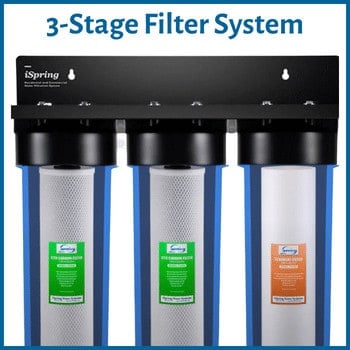
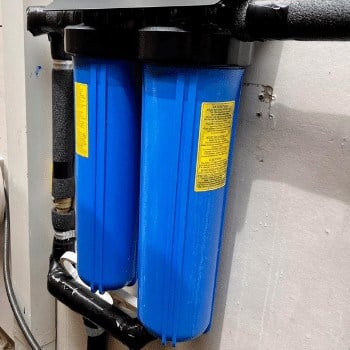
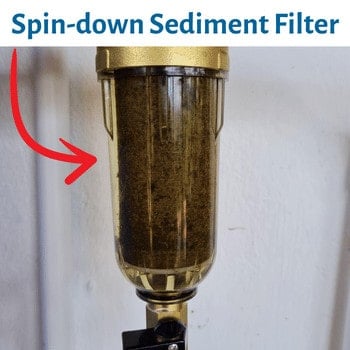
If you want something simple that boosts taste, keeps your water pressure strong, and doesn’t require much upkeep, the iSpring is a solid pick. Just keep in mind — it’s not built for outdoor installs and doesn’t cover bacteria, so if that’s your concern, a UV system might be a better fit.
| 👍 Pros |
|---|
| 🧰 Surprisingly durable build — solid housing that doesn’t feel flimsy or prone to leaks |
| 🛠️ Easy filter swaps — cartridges twist off cleanly without tools or a mess |
| 🚫 No electronic parts — less maintenance and fewer failure points |
| 🔄 Modular design — lets you mix and match cartridges as water conditions change |
| 🚿 Strong flow rate — keeps up with high water demand in busy households |
| 🚫 Cons |
|---|
| 🦠 Doesn’t target bacteria or viruses — no UV add-on |
| 🚫 Not built for outdoor installs (keep it sheltered) |
| ⏲️ No filter change reminder — mark your calendar |
🧠 Worth Remembering: The iSpring 3-stage doesn’t try to be flashy — but if you’ve got heavy sediment and want something simple and dependable, it’s hard to beat at this price. We’ve broken down the pros, quirks, and long-term upkeep in our full system review.
#7 Express Water Heavy Metal Filter
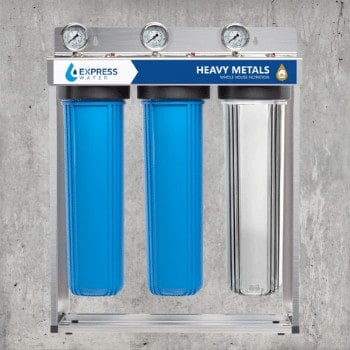
If your water’s testing high for metals like lead or arsenic, but you’re not ready for a big tank system, this triple-stage unit from Express Water is worth a look. It’s basic, but effective — and doesn’t ask much of you when it comes to maintenance.
You won’t get app controls or fancy upgrades here, but that’s kind of the point — just clean, filtered water without the drama.
Features:
- ✅ Quick-swap filters — No tools needed
- 🧪 KDF85 media — Targets lead & heavy metals
- 📊 Stage gauges — Track filter life easily
- 🚰 15 GPM flow — Great for multi-use homes
- 🧱 Steel housing — Built to last, no flimsy parts
Not every well needs bells and whistles. If your main issue is heavy metals or murky water, this setup gets the job done without much hassle. Just keep in mind — it’s not built to handle dissolved iron. For that, the SoftPro might be a smarter pick.
| ✅ Pros |
|---|
| ⚙️ Hardware feels durable — not flimsy like some budget units |
| 🔧 Easy access housing makes filter swaps way less annoying |
| 📦 Ships pre-assembled so you’re not sorting parts for hours |
| 📉 Surprisingly good flow consistency for a 3-stage setup |
| 🚫 No need to fuss with media or backwashing — it’s set-it-and-go |
| ⚠️ Cons |
|---|
| 🛠️ Filter changes are tool-free but still a bit messy |
| 📏 Housing size can be bulky if you’re tight on wall space |
| ⏳ Needs more frequent swaps if your water has lots of silt |
| ❄️ Not rated for freezing temps — install indoors only |
| 🔇 No noise issues, but no filter change alerts either |
🔧 Good to Know: Express Water’s cartridge system is solid for the price, but it’s best for moderate contaminant loads. If you’re trying to tackle iron bacteria or sulfur odors, this won’t cut it. For more demanding well setups, you might want to check out a system with AIO or peroxide-based filtration.
#8 Culligan WH-HD200-C Best For Sediment
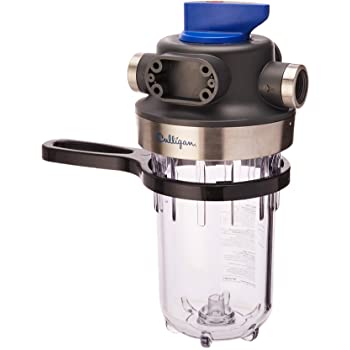
If your well water’s leaving grit in your faucets or staining your dishes, this filter does exactly what it’s supposed to: catch the dirt before it hits your pipes.
You don’t get bells and whistles, but you do get dependable protection from heavy sediment — and that’s often all you need.
Features:
- 🔎 Clear filter housing for quick visual checks
- 🧱 Heavy-duty design handles high-sediment loads
- 🧩 Supports 1–50 micron cartridges
- 🔧 Standard 1” ports fit most plumbing setups
- 🧰 Includes filter wrench for easy changes
It’s a no-fuss choice if your well water’s full of sediment. It handles sand, silt, and rust reliably. That said, it’s limited — so if you’ve also got taste issues or chemical concerns, something more robust might be a better fit.
| ✅ Pros |
|---|
| 💪 Durable housing handles gritty well water without leaking |
| 🔁 Accepts standard 10” filters — easy and affordable to replace |
| 🛠️ Includes a filter wrench for quick cartridge swaps |
| 💸 Very low cost for a whole-house setup |
| 🚿 Good flow rate (8 GPM) for small homes or cabins |
| ❌ Cons |
|---|
| 🔧 Requires more frequent filter changes than higher-end models |
| 📦 Filter cartridges not included — must be purchased separately |
| 📏 Limited to sediment only — won’t reduce chlorine, metals, or odors |
| 💧 Lower capacity (24,000 gal.) compared to other systems on this list |
| ❄️ Not rated for freezing climates — indoor installs only |
💡 Good to know: The Culligan is a solid pick if you just need a basic pre-filter to knock out rust, dirt, and grit. It’s budget-friendly and reliable, though keep in mind the filters are sold separately — and this isn’t meant to be your only line of defense. Read our full review.
#9 Springwell Calcite pH Neutralizer
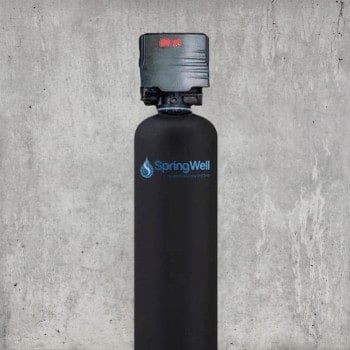
If your water’s slowly wrecking pipes or fixtures, this system earns its keep. The SCN1 quietly balances pH levels using natural calcite — no harsh chemicals, no guessing games.
You won’t notice it running, but your plumbing will thank you (and your coffee might even taste better). Acidic water is sneaky — this stops the damage before it starts.
Features
- 🔄 Auto-backwash keeps things flowing without manual flushes
- 📲 App-controlled settings make tweaking easy from your phone
- 💪 Corrosion-resistant tank built for acidic well water
- 🧱 One-piece media tank design means fewer leaks, fewer headaches
- 🔧 Top-loading port makes calcite refills a 2-minute job
Use Coupon Code: QWL5 to save!
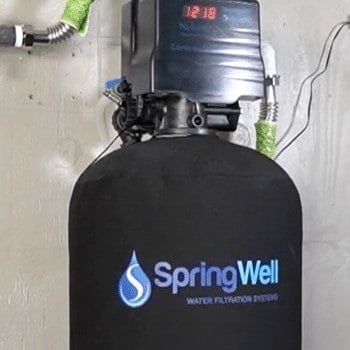
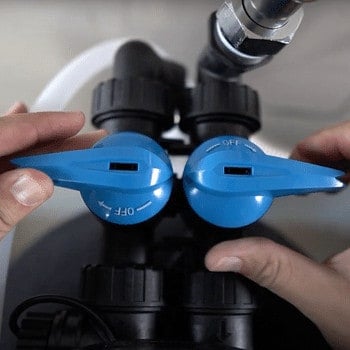
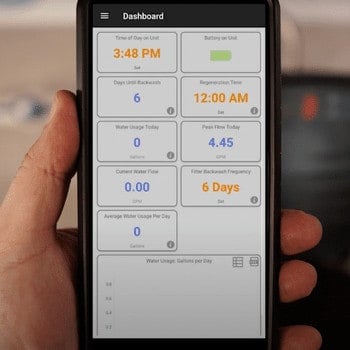
If your well water’s eating away at your plumbing or has that sour taste, SpringWell’s Calcite system quietly fixes it behind the scenes. It’s ideal for low pH water — no pressure loss, no constant fuss. Just a heads-up though: it’s not built to tackle iron or sulfur, so if those are issues too, you’ll want to pair it with a more comprehensive filter.
4.6+ rating with thousands of positive reviews.
| 👍 Pro |
|---|
| 🛡️ Helps prevent corrosion in pipes and fixtures |
| 📱 App control makes backwash timing easy to adjust |
| 🔇 Quiet, steady performance — runs in the background |
| 🔁 Pairs well with softeners or RO for full-system coverage |
| 🧪 Large tank means less frequent calcite refills |
| 👎 Con |
|---|
| 📦 Bulky — not ideal if you’re short on space |
| 🔧 Requires occasional top-up of calcite media |
| ⚠️ Won’t fix taste, odor, or major contaminants on its own |
| 💧 Not a one-size-fits-all — check your starting pH first |
| 💸 Upfront cost is higher than basic neutralizers |
🔧 Good to Know: This system doesn’t filter out metals or bacteria — it’s all about neutralizing acidity to protect your plumbing and prep your water for filtration. If you’re seeing blue-green stains or corroded fittings, this is the kind of system that can quietly save you thousands.
How We Chose
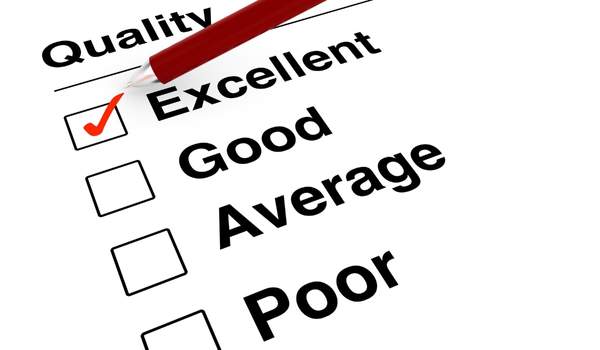
We didn’t just glance at specs and call it a day. We looked at how these systems actually perform in the real world — not just what the box says. From iron-heavy wells to high-sediment setups, we focused on systems that solve problems people really have, not just filter water for the sake of filtering it.
| 🔍 What We Evaluated | Why It Mattered |
|---|---|
| Contaminant Removal | We favored systems that tackled real well water issues like iron, sulfur, manganese, sediment, and bacteria. |
| Taste & Clarity | Water shouldn’t just be safe — it should look and taste clean too. We noted which systems actually improved this. |
| Installation & Maintenance | We leaned toward systems that are DIY-friendly or at least simple to live with once installed. |
| Warranty & Support | Strong support and solid warranties show the brand stands behind its product long-term. |
| Certifications | NSF certification isn’t everything — but it’s a strong signal the system does what it claims to. |
| Longevity & Cost of Ownership | We looked at how often filters need changing, long-term durability, and upkeep costs. |
The goal? Recommend systems that give you peace of mind, not another chore. Whether you’re battling sulfur smells, iron stains, or mystery contaminants, we found systems that don’t just treat water — they make life easier.
Buyers Guide
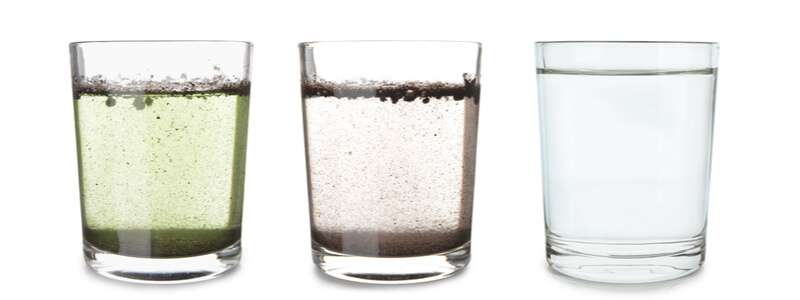
Over 60 million Americans rely on private wells — and many have no idea what’s flowing from their tap. Unlike city water, there’s no municipal monitoring. If your water smells off, leaves stains, or just tastes strange, it’s time to take control.
Even crystal-clear well water can carry invisible risks — from metals like lead or arsenic to bacteria and sulfur. That’s why testing isn’t just a suggestion — it’s step one.
🚨 What’s Lurking in Your Well?
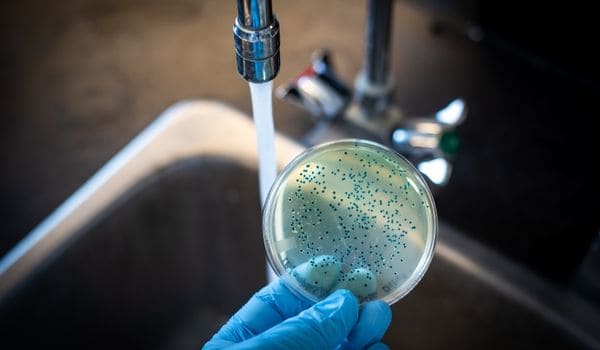
These common culprits are why filtration matters:
- Iron & Manganese – Cause rust stains, bitter metallic taste, and black sludge
- Sulfur – The infamous rotten egg odor
- Nitrates – Especially dangerous for infants and pregnant women
- Coliform Bacteria – Can indicate contamination from animal or human waste
- Lead, Arsenic & Radon – Naturally occurring but hazardous at high levels
- VOC’s & Pesticides – Common near farms or industrial areas
💡 Pro Tip: You don’t need to guess. A simple lab test will show you exactly what’s in your water — and help you choose the right filter.
🔬 Why Well Water Testing Comes First
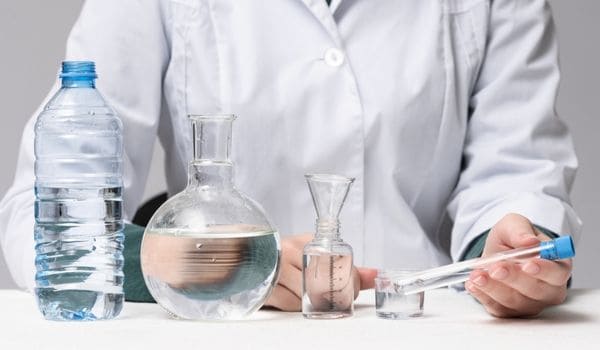
Even if your water looks crystal clear, it could be hiding serious issues — like lead, bacteria, or arsenic. And here’s the thing: no filter works unless it’s solving the right problem.
💧 Start with a water test — it’s the only way to know what you’re actually drinking.
There are two ways to test:
- 🧪 Lab Testing – The gold standard. Accurate, detailed results with specific contaminant levels.
- 🏠 At-Home Kits – Good for quick checks (like pH, hardness, and iron), but limited for things like lead or bacteria.
💡 Pro Tip: If your water smells weird, stains your sink, or tastes metallic — don’t guess. Test it. It’ll save you time, money, and regret.
🧭 How To Choose the Right Filter (Without Guesswork)

Now that you know your options, let’s make sense of what actually works for your water. Here’s how to narrow it down:
| 🚩 Water Issue | What to Look For |
|---|---|
| Iron (orange stains, metallic taste) | 🟢 Air Injection or Katalox-based systems — skip carbon-only units |
| Sulfur smell (rotten eggs) | 💨 Look for oxidation + media like greensand or hydrogen peroxide injection |
| Manganese (black slime) | 🧪 Oxidizing filters with strong backwashing — not cartridges |
| Coliform or E. coli bacteria | 💡 Add UV or chlorination — filters alone won’t solve it |
| Heavy metals (like lead or arsenic) | ⚙️ Use reverse osmosis or KDF — test levels first |
| Low pH (acidic water, blue-green stains) | 🧱 A calcite pH neutralizer helps protect your plumbing |
| Cloudiness or sediment | 🔎 Install a sediment pre-filter (5 micron or less) |
| “Flat” or chemical taste | 🥤 Carbon block filters improve taste & odor |
💡 Pro Tip: You might need a combo system — like an iron filter with a UV add-on, or a softener plus reverse osmosis. Layering filters = better results.
📏 Sizing Your System Right (Capacity, Flow & Microns)
A well filter isn’t one-size-fits-all. The right fit depends on how much water your home uses — and what kind of particles you’re trying to stop.
| 📊 Factor | What To Know |
|---|---|
| 💧 Flow Rate (GPM) | Check how many gallons per minute your home uses — 6–12 GPM is typical. A bucket test can help you calculate this quickly. |
| 🧪 Micron Rating | Lower = finer filtration. 5 microns stops sediment and rust. 0.01–0.0001 microns (RO) tackles fluoride, arsenic, and viruses. |
| 📦 Total Capacity | Look for systems rated 500k–1M gallons if you want fewer filter changes and better long-term value. |
🔧 Pro Tip: If your shower pressure drops when someone runs the dishwasher, it’s probably a flow rate issue — not just your pump.
🏅 What Really Matters? Certifications & Support
Not all filters are created equal — and flashy marketing isn’t the same as proof. That’s where third-party testing and real customer service come in.
| ✅ Certification | What It Verifies |
|---|---|
| 🔵 NSF/ANSI 53 | Removes health-related contaminants like lead, VOCs, nitrates, and pesticides. |
| 🧪 NSF/ANSI 42 | Improves taste, smell, and clarity by reducing chlorine, particulates, and odor. |
| 🔐 NSF/ANSI 61 | Confirms filter components won’t leach unsafe materials into your water. |
| 🏅 WQA Gold Seal | Verifies structural integrity, performance, and manufacturer accountability. |
🛠️ Good to Know: Companies that offer long warranties, free support, and detailed manuals are usually the ones that stand behind their product — and make your life easier after the install.
🧪 What Type of Filter Do You Actually Need?
Not all well water problems need the same fix. Here’s how the most common filter types compare — and where they shine:
| 🔍 Filter Type | What It’s Good At |
|---|---|
| 🌬️ Air Injection (AIO) | Tackles iron, manganese, and sulfur by oxidizing them into filterable solids — great for smelly or rusty water. |
| 🧊 Carbon Block | Polishes taste and smell by absorbing chlorine byproducts, pesticides, and other chemical runoff. |
| 🧪 KDF Media | Reduces heavy metals like lead and mercury — often used as a pre-filter with carbon for stronger defense. |
| ☢️ UV Light | Destroys bacteria, viruses, and other microorganisms — perfect if coliform or E. coli are detected. |
| 🧱 Sediment Filter | Catches sand, rust, and grit that clog plumbing and damage other filters. A must-have first stage for wells. |
⚠️ Heads Up: Just because your water looks clean doesn’t mean it’s safe. The best setup often combines multiple filter types to catch everything from sediment to sulfur.
🪣 How to Check Your Well Flow Rate (No Math Required)
Before picking a filter, you’ll want to know how much water your system can push. A slow well may not keep up with high-flow systems.
Here’s an easy test:
- Make sure no one is using water inside your home.
- Grab a 5-gallon bucket and time how long it takes to fill from a spigot near your pressure tank.
- Match your time to the table below:
| ⏱️ Time (Seconds) | Estimated GPM |
|---|---|
| 75–100 sec | 3 GPM |
| 60–74 sec | 4 GPM |
| 50–59 sec | 5 GPM |
| 38–49 sec | 6–7 GPM |
| 30–37 sec | 8–9 GPM |
| Under 30 sec | 10+ GPM |
💡 Pro Tip: If your GPM is under 6, avoid backwashing systems unless you install a storage tank or booster pump.
💸 Installation & Maintenance Costs (What to Expect)

Whole house filters aren’t cheap — but the wrong one can cost even more over time. Here’s what to plan for:
| 🛠️ System Type | Typical Install Cost | Annual Upkeep |
|---|---|---|
| Iron / Sulfur Filter (tank-based) | $500–$1,200 | $50–$150 |
| Cartridge System (3-stage) | $300–$800 | $150–$350 |
| Reverse Osmosis (whole home) | $800–$1,500 | $200–$300 |
| UV Disinfection | $350–$600 | $75–$200 |
| Calcite pH Neutralizer | $500–$900 | $100–$200 |
🔍 Watch Out: Some systems look cheap upfront but require constant cartridge swaps or proprietary filters that add up fast.
✅ Smart Move: Prioritize filters with longer-lasting media (like AIO tanks or KDF/carbon combos) to save money long-term.
🧯 Troubleshooting Specific Well Water Issues

Some well water problems need targeted fixes — a general filter won’t cut it. Here’s how to match the right tech to the job:
| 🚩 Problem | ✅ Best Solution |
|---|---|
| High Iron (orange stains, metallic taste) | Air injection + sediment pre-filter |
| Rotten egg odor (Hydrogen sulfide) | Oxidation filter with greensand or peroxide system |
| Coliform or E. coli | UV treatment or chlorination system |
| Acidic water (low pH, blue/green stains) | Calcite pH neutralizer |
| Arsenic | RO system with alumina cartridge or point-of-use filter |
| Lead & heavy metals | KDF media + carbon filter or RO at the tap |
🔧 Good to Know: If your water has multiple issues — like iron and bacteria — you’ll likely need a layered solution (e.g., AIO + UV).
⚖️ Whole House Filter Pros & Cons (The Honest Tradeoffs)
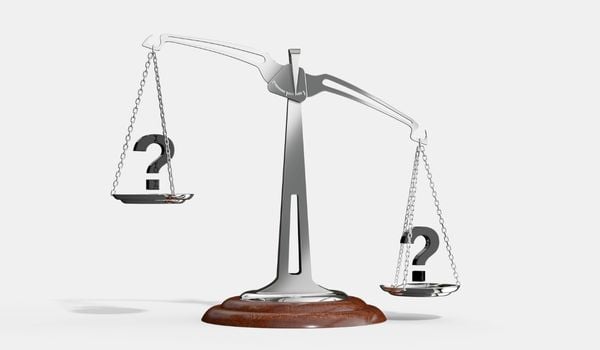
Installing a whole home filter is one of the smartest moves for well owners — but it’s not all plug-and-play. These systems can seriously upgrade your water quality — but.. they’re not perfect. Some tradeoffs are worth it, and others… not so much.
Let’s take a quick, honest look at both sides:
| 👍 Pros | 👎 Cons |
|---|---|
| ✅ Filters all water entering your home — not just one tap | ⚠️ Upfront cost can range from $500 to $2,500+ |
| ✅ Reduces odors, stains, and health risks in one solution | 🔧 Most systems need pro installation or serious DIY skills |
| ✅ Removes contaminants you can’t see or taste | 💸 Annual maintenance costs can add up (filters, salt, peroxide) |
| ✅ Improves appliance life by reducing buildup & corrosion | 🧪 Requires testing to match the right system to your water |
| ✅ Can be paired with add-ons like UV or RO for full coverage | 📏 Choosing the wrong size or filter type can lead to poor results |
💡 Bottom line: Whole house filters are one of the best long-term moves for well owners — but only if you size them right and know what you’re up against. Test first, then filter smart.
🛡️ Filter Warranties & Money-Back Guarantees
Before you drop four figures on a whole house filter, it’s worth knowing who actually stands behind their product — and for how long. Here’s how the most trusted brands compare:
| 🔧 Brand | Warranty | Money-Back Guarantee |
|---|---|---|
| SpringWell | Lifetime | 6 months |
| Aquasana | 6 years | 90 days |
| Pentair | 5 years | 60 days |
| iSpring | 1 year | 30 days |
💡 Pro Tip: Be sure to check the fine print — some warranties don’t cover tanks or electronics. Always read the service terms before buying.
🧪 Still Not Sure Which Filter You Need?
The smartest move is to start with a water test. It’ll show you exactly what you’re dealing with — from common issues like: iron or sulfur to more serious concerns like bacteria or heavy metals.
Once you have the results, matching the right system becomes a whole lot easier — and a lot less stressful.
✅ A good test takes out the guesswork so you can filter with confidence.
⚠️ What NOT to Do When Buying a Well Water Filter
Even smart buyers make mistakes. These are the most common regrets we see — and how to avoid them:
- ❌ Skipping the water test You’ll likely waste money on a filter that doesn’t solve your actual issue.
- ❌ Choosing the cheapest system Some look like a steal — until you’re swapping filters every month.
- ❌ Buying a system that’s too small If your GPM rating is off, get ready for weak showers and slow fill times.
- ❌ Thinking “one filter fits all” Most well systems need a combo setup — like iron + UV, or RO + softener.
- ❌ Forgetting maintenance If the system has proprietary cartridges or hard-to-find parts, skip it.
💡 Pro Tip: Choosing a well water filter doesn’t have to feel risky — just stay focused on your test results, your flow rate, and your future maintenance. When in doubt, start simple and scale up. It’s easier (and cheaper) to layer solutions than undo a bad one.
🏁 Final Thoughts
Owning a well puts you in charge — but it also means the safety of your water is entirely up to you. The good news? You’ve already done the hardest part: figuring out what to look for.
Whether you’re fighting off rust stains, sulfur smells, or something more serious, there is a system that can fix it. And now, you’ve got the knowledge to choose one that actually works — not just one that looks good in a spec sheet.
💡 Pro Tip: Still unsure? Start with a water test. It’s the best way to avoid guessing — and it makes filter shopping a whole lot easier.
 105 people found this helpful. Was this guide helpful to you?
105 people found this helpful. Was this guide helpful to you? 
